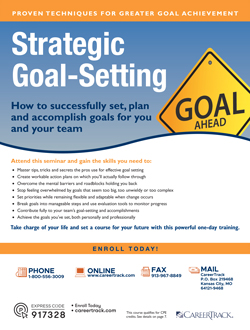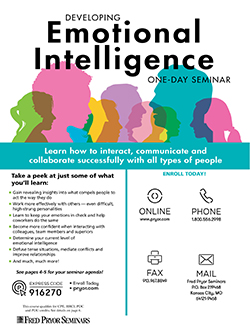Setting Organizational Goals: A Framework

We often think of New Year’s resolutions in personal terms – thinking about and writing down goals or activities we would like to achieve and do in the coming months and year. It is also a good time for organizations to engage in developing or refining organizational goals, either to mark the start of the new year or a new quarter.
For many people, these activities are somewhat independent – you might develop personal resolutions, while also separately participating or facilitating goal planning in an organization. In this article, we consider how these two worlds can be brought together. Often, we think about work-life balance as making tradeoffs between work and home. However, when it comes to goals, the two may be able to support one another when considered together.
Where Goals Come From
The first good question is asking where goals come from. Do you know what they are and how they come to be for your team or your organization? It is good general practice to be aware of your organization’s strategic and tactical goals, even if they are not well publicized in the organization, allowing you to align your work and communications against these priorities. In general, goal planning tends to be both a top-down and bottom-up process and can be formal or informal.
For example, the organization may have certain targets or metrics based on previous sales, revenue, service targets or customer counts, which cascade to different teams. Teams may also be asked to propose specific goals or targets for their organization, or to report progress to date and any adjustments needed at the start of the year.
This process may be formal or informal depending on the size and culture of the organization, and based on what external stakeholders the organization is accountable to. This includes shareholders, donors, other funding organizations or customers themselves.
SAVE $10 AND TRAIN ON THIS TOPIC TODAY
So, how does this organizational goal planning link to personal resolutions? When you consider your organization’s or team’s goals and targets, it helps to consider your own growth and development. If your organization is working on developing a new product or service area or building a new customer base, it may be useful for both the organization and for you to explore new opportunities that align with those goals. Here are some examples:
- You may want to develop new workplace competencies that support organizational goals, such as project management, marketing, writing or oral communications. These general competencies may help you advance the organization’s goals, while creating new growth opportunities for you.
- You may want to explore new technology tools and skills that expand your resume while also supporting your team’s needs. Picking up some new Microsoft® Excel skills could help with goal tracking or reporting, for example. Learning new elements of PowerPoint® could supplement your presentation and group communication skills.
- Think about some networking and relationship building you might do within or outside your organization to build your stakeholder connections. These activities help your team and organization find new resources, partnerships and opportunities which can contribute to your career advancement and build deeper social support and new friends over time.
- Consider which goals from last year were not achieved. Do they remain important? Why weren’t they completed? If they remain valid, consider steps to revive them and move them forward in new ways that may be more successful.
Pryor offers several training courses in both personal and professional development areas that help you with this blended work-life goal setting process. For example, search our catalogue for specialized training in different professional areas, including Finance, Project Management, Customer Service, Human Resources and Information Technology, or training in softer skill areas, like Emotional Intelligence, Leadership and Communications.
Implementing and Communicating Goals
It’s one thing to write goals down on a piece of paper – it’s another to make them real. Once you develop your goals, or receive them from your team or organization, it is important to think through implementation. Depending on the size and complexity of the goals, this could involve:
- Developing a project plan that lists the different activities, milestones and deliverables involved in achieving the goal
- Writing due dates into the calendar for critical deadlines
- Building out plans for components that will contribute to the goal – like an outline for a new service area, a sketch of a new product or a summary of a new target customer group
- Identifying team members or other colleagues that may be involved in goal achievement
Part of blending work and personal goals is to take a big-picture look at the calendar over several months or the full year. Identify times that will be particularly busy at work, and you may see opportunities to build in quieter times. Consider quieter times to schedule personal leave in advance or take a longer training class. This planning allows you to balance commitments so that not everything is happening at once and helps manage expectations with colleagues and leadership throughout the year.
Once you have articulated elements of the goals, ongoing communication is critical. First, it is important to communicate about the goals and plans themselves, to build support – this is true for both personal and professional goals. Then, as the different elements of the goals are achieved, it is important to communicate that progress to key stakeholders – key team members, customers and leadership. This may take multiple forms:
- Casual updates during status meetings or team meetings
- Formal update presentations or written reports
- Organization newsletter or email updates
- Update conversations with key stakeholders over the year
- Active communication with team members about goals and achievements
- Communicate the launch of products and services once created and ready for delivery
Pryor’s Grammar and Business Writing courses and seminars will help you brush up on effective business writing skills to deliver these updates with clarity and professionalism.
Maintaining Accountability and Celebrating Success
There is no point in having goals if the organization doesn’t follow though to ensure completion. As such, accountability is a critical part of the goal and planning process. Different organizations have different ways of tracking and reporting on metrics at different levels throughout the year – there are also processes for adjusting goals as the year plays out. These processes are important for making sure the organization stays on track.
Personal goal planning tends to be a bit different – often, people set resolutions and then forget them within a few weeks or months. This is another good reason for integrating personal goal planning with organizational planning – ongoing organization accountability may help you with accountability on the personal front as well.
Here’s an example of how this might work. One person we know set a New Year’s resolution to lose 10 pounds before he needed to make a big presentation at a professional conference at the start of June. This was a way to set a reasonable personal goal that was linked to an event with importance to him – while his work colleagues and the conference audience didn’t know, or likely care, about his weight, it kept him on track because it was a tangible and reasonable deadline that he helped hold himself accountable.
With accountability also comes celebration! When we say we want to “hold someone accountable,” it is often meant as a negative comment – intended to make sure they reach a goal or a target. Accountability is also, however, a chance to create an accounting of all that is good – what has been achieved. Here are some examples:
- Writing a personal or team note to acknowledge a milestone achieved or project completed
- If you are leader of a team, nominating a team for an award or hosting an awards event
- Nominating a team member for an award
- Using the communications ideas above to document and praise the work of others through both informal and formal communications throughout the year
It can be both exciting and stressful to set and plan goals for the year ahead. Engaging in this process holistically across both work and personal worlds may help bring both into focus and alignment for more effective work-life balance in the weeks and months ahead. A busy work window might be followed by a personal break; vacation time can be more thoughtfully negotiated; and you may be able to strategically schedule self-development, educational programs and mentoring and networking activities in ways that help both you and your organization move well together into the new year.











